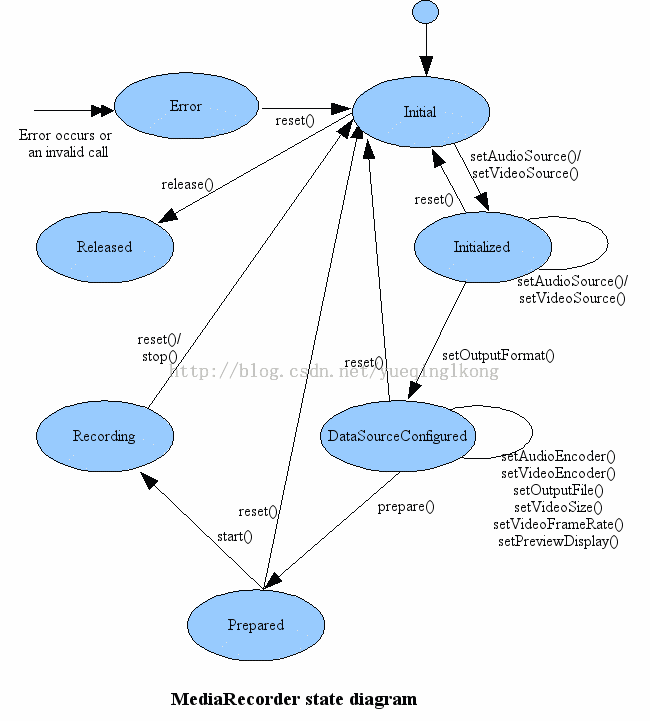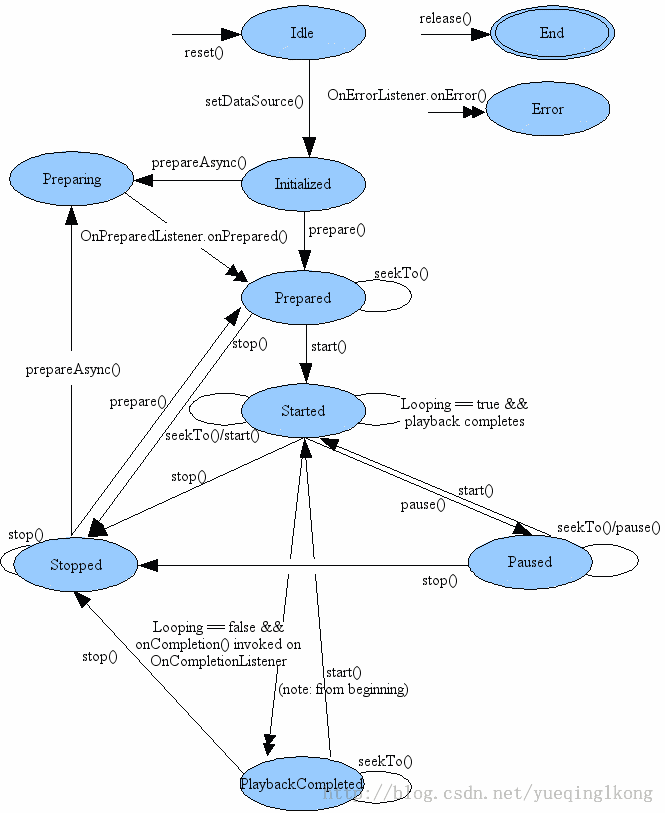简介录音和播放音频实现
1.MediaRecorder及MediaPlayer:
MediaRecorder类父类是object,位于media包下,是用来录制音频和视频。
下面是录音模型:
看起来很是复杂的样子,当然了解下流程还是有必要的。至少你知道如果想重新初始化的话,可以直接使用 reset()方法,不管在哪个阶段都可以重置,有图有真相是吧!
其他的话,也没啥说的,流程都是规范化了的,改动的空间不大,看api好了。
MediaPlayer也位于media包下,直接继承与object类,可以用来放音频/视频的文件和流。
下面是工作流程:
看起来比录音的流程更复杂了,更深的东西我们暂时就不深究了。相对于录音来说,主要多了暂停,回放的状态,方法中更是添加了循环,进度等东西,更多的就不说了,有兴趣的童鞋可以慢慢研究,可以对下面的实例进行扩展。
首先,我对功能进行了封装。
/**
* 录音的类,封装了录音/播放的开始停止功能
*/
public class MyRecord {
/** 录音 */
private MediaRecorder mRecorder;
/** 播放 */
private MediaPlayer mPlayer;
private String path = "";
public static MyRecord myRecord = null;
// 单例
private MyRecord() {
mkMyDir();
};
public static synchronized MyRecord getInstance() {
if (myRecord == null) {
myRecord = new MyRecord();
}
return myRecord;
}
// 在sdcard上创建文件夹
public void mkMyDir() {
File dir = new File(Environment.getExternalStorageDirectory()
.getAbsolutePath() + "/TestRecord");
path = dir.getAbsolutePath();
dir.mkdir();
}
// 获取文件夹路径
public String getPath() {
return path;
}
// 开始录音
public void startRecord(String filePath) {
mRecorder = new MediaRecorder();
mRecorder.setAudioSource(MediaRecorder.AudioSource.MIC);
mRecorder.setOutputFormat(MediaRecorder.OutputFormat.THREE_GPP);
mRecorder.setOutputFile(filePath);
mRecorder.setAudioEncoder(MediaRecorder.AudioEncoder.AMR_NB);
// 设定录音文件大小 ,大概是1s 就是1k的大小
// mRecorder.setMaxFileSize(10 * 1024);
// 设定录音的最大时长,貌似这个跟上面的数据差距有点大 ,最大得到的数据是17k多的数据
// mRecorder.setMaxDuration(10 * 1000);
try {
mRecorder.prepare();
} catch (IllegalStateException e) {
// TODO Auto-generated catch block
e.printStackTrace();
} catch (IOException e) {
// TODO Auto-generated catch block
e.printStackTrace();
}
mRecorder.start();
}
// 停止录音
public void stopRecord() {
mRecorder.stop();
mRecorder.release();
mRecorder = null;
}
// 播放录音
public void startPlay(String fileName) {
mPlayer = new MediaPlayer();
try {
mPlayer.setDataSource(fileName);
mPlayer.prepare();
mPlayer.start();
} catch (IOException e) {
e.printStackTrace();
}
}
// 停止播放
public void stopPlay() {
mPlayer.stop();
mPlayer.release();
mPlayer = null;
}
}
使用单例,只有一个实例,避免了冗余。文件的路径,其实应该是提供接口的,想想觉得固定了好点,提供给外面的路径就好了。
然后是使用了:
public class TestVoice extends Activity implements OnClickListener {
private Button startR;
private Button stopR;
private Button startP;
private Button stopP;
private MyRecord myRecord;
private String path = "/test.3gp";
@Override
protected void onCreate(Bundle savedInstanceState) {
// TODO Auto-generated method stub
super.onCreate(savedInstanceState);
setContentView(R.layout.acy_testvoice);
initView();
}
public void initView() {
myRecord = MyRecord.getInstance();
path = myRecord.getPath() + path;
startR = (Button) findViewById(R.id.startRecord);
stopR = (Button) findViewById(R.id.stopRecord);
startP = (Button) findViewById(R.id.startPlay);
stopP = (Button) findViewById(R.id.stopPlay);
startR.setOnClickListener(this);
stopR.setOnClickListener(this);
startP.setOnClickListener(this);
stopP.setOnClickListener(this);
}
@Override
public void onClick(View v) {
// TODO Auto-generated method stub
if (v == startR) {
myRecord.startRecord(path);
} else if (v == stopR) {
myRecord.stopRecord();
} else if (v == startP) {
myRecord.startPlay(path);
} else if (v == stopP) {
myRecord.stopPlay();
}
}
}
2.AudioTrack及AudioRecord:
这是通过流读取操作来录制/播放音频文件的,相对于上面的方法来对解码器更加依赖来讲,这是直接读取的是pcm文件。不过好像录音的效果不咋好,通过对流的处理是可以实现降噪的,在网上没找到比较好的办法,在这就不写了,因为我也不懂那个。
public class AltAudioRecorder extends Activity implements OnClickListener {
private RecordAudio recordTask;
private PlayAudio playTask;
private Button startRecordingButton, stopRecordingButton,
startPlaybackButton, stopPlaybackButton;
private TextView statusText;
File recordingFile;
boolean isRecording = false;
boolean isPlaying = false;
// 要确定在人耳的接收频率以内,
int frequency = 11025;
int channelConfiguration = AudioFormat.CHANNEL_CONFIGURATION_STEREO;
int audioEncoding = AudioFormat.ENCODING_PCM_16BIT;
@Override
public void onCreate(Bundle savedInstanceState) {
super.onCreate(savedInstanceState);
setContentView(R.layout.acy_record);
statusText = (TextView) this.findViewById(R.id.StatusTextView);
startRecordingButton = (Button) this
.findViewById(R.id.StartRecordingButton);
stopRecordingButton = (Button) this
.findViewById(R.id.StopRecordingButton);
startPlaybackButton = (Button) this
.findViewById(R.id.StartPlaybackButton);
stopPlaybackButton = (Button) this
.findViewById(R.id.StopPlaybackButton);
startRecordingButton.setOnClickListener(this);
stopRecordingButton.setOnClickListener(this);
startPlaybackButton.setOnClickListener(this);
stopPlaybackButton.setOnClickListener(this);
File path = new File(Environment.getExternalStorageDirectory()
.getAbsolutePath() + "/Android/data/AudioRecorder/files/");
path.mkdirs();
try {
recordingFile = File.createTempFile("recording", ".pcm", path);
} catch (Exception e) {
throw new RuntimeException("Couldn't create file on SD card", e);
}
}
public void onClick(View v) {
if (v == startRecordingButton) {
record();
} else if (v == stopRecordingButton) {
stopRecording();
} else if (v == startPlaybackButton) {
play();
} else if (v == stopPlaybackButton) {
stopPlaying();
}
}
//开始录音
public void play() {
playTask = new PlayAudio();
playTask.execute();
}
//停止录音
public void stopPlaying() {
isPlaying = false;
}
//开始播放
public void record() {
recordTask = new RecordAudio();
recordTask.execute();
}
//停止播放
public void stopRecording() {
isRecording = false;
}
private class PlayAudio extends AsyncTask<Void, Integer, Void> {
@Override
protected Void doInBackground(Void... params) {
isPlaying = true;
// 返回实例创建后的最好缓冲区
int bufferSize = AudioTrack.getMinBufferSize(frequency,
channelConfiguration, audioEncoding);
short[] audiodata = new short[bufferSize / 4];
try {
DataInputStream dis = new DataInputStream(
new BufferedInputStream(new FileInputStream(
recordingFile)));
AudioTrack audioTrack = new AudioTrack(
// 流类型
AudioManager.STREAM_MUSIC,
// 音频数据的采样率
frequency,
// 声道 为双声道立体声
channelConfiguration,
// 设置音频数据块为16位
audioEncoding,
// 在录制过程中,音频数据写入缓冲区的总数(字节)
bufferSize,
// 设置模式类型为流
AudioTrack.MODE_STREAM);
audioTrack.play();
while (isPlaying && dis.available() > 0) {
int i = 0;
while (dis.available() > 0 && i < audiodata.length) {
audiodata[i] = dis.readShort();
i++;
}
audioTrack.write(audiodata, 0, audiodata.length);
}
dis.close();
} catch (Throwable t) {
Log.e("AudioTrack", "Playback Failed");
}
return null;
}
}
private class RecordAudio extends AsyncTask<Void, Integer, Void> {
@Override
protected Void doInBackground(Void... params) {
isRecording = true;
try {
DataOutputStream dos = new DataOutputStream(
new BufferedOutputStream(new FileOutputStream(
recordingFile)));
int bufferSize = AudioRecord.getMinBufferSize(frequency,
channelConfiguration, audioEncoding);
AudioRecord audioRecord = new AudioRecord(
MediaRecorder.AudioSource.MIC, frequency,
channelConfiguration, audioEncoding, bufferSize);
short[] buffer = new short[bufferSize];
audioRecord.startRecording();
int r = 0;
while (isRecording) {
int bufferReadResult = audioRecord.read(buffer, 0,
bufferSize);
for (int i = 0; i < bufferReadResult; i++) {
dos.writeShort(buffer[i]);
}
publishProgress(new Integer(r));
r++;
}
audioRecord.stop();
dos.close();
} catch (Throwable t) {
Log.e("AudioRecord", "Recording Failed");
}
return null;
}
protected void onProgressUpdate(Integer... progress) {
statusText.setText(progress[0].toString());
}
protected void onPostExecute(Void result) {
}
}
}
注意:
1.android.media.MediaPlayer.finalize() timed out after 10 seconds
在onPause()中调用MediaPlayer.release(),在onStop()中释放对象:
mPlayer.stop(); mPlayer.release(); mPlayer = null;

